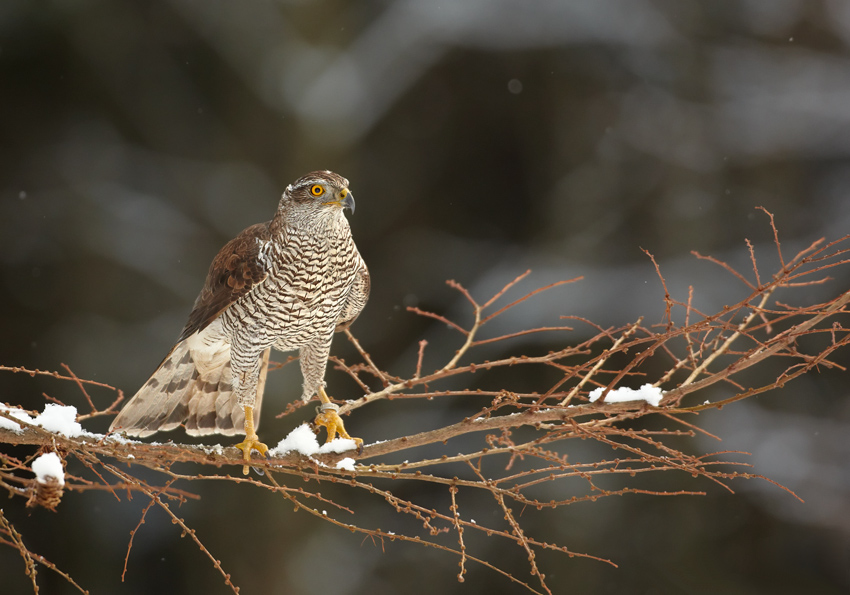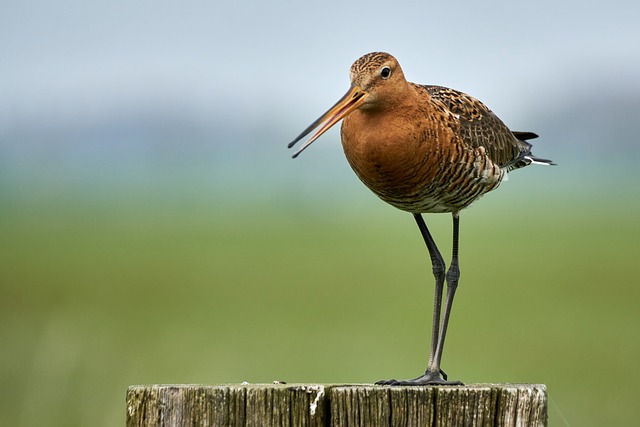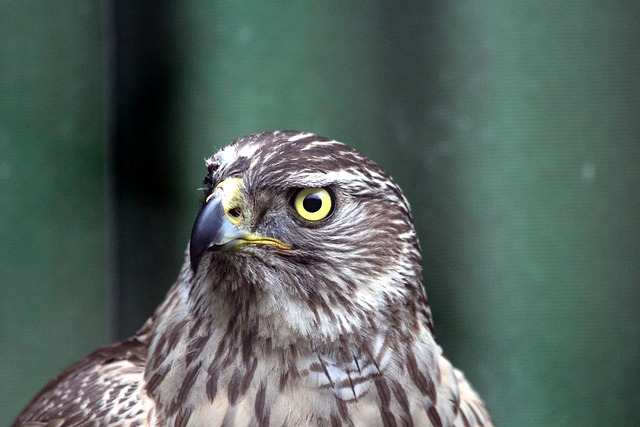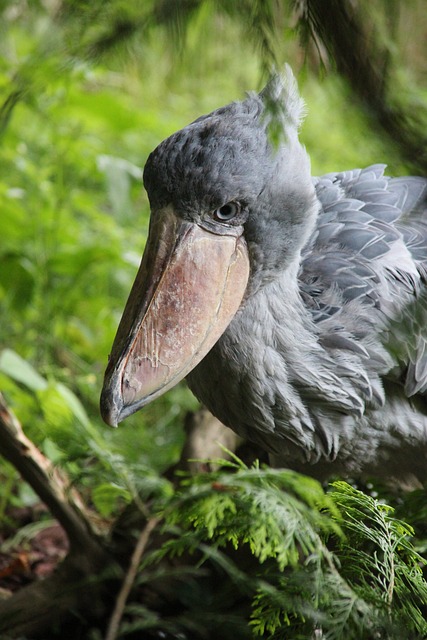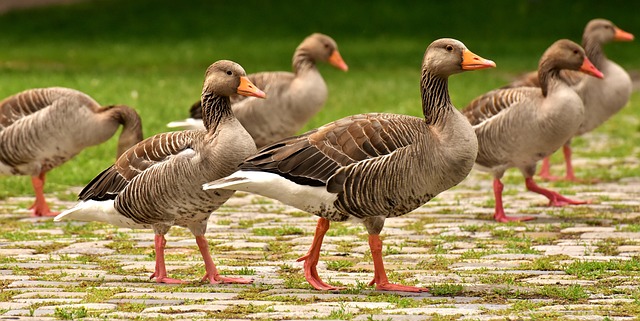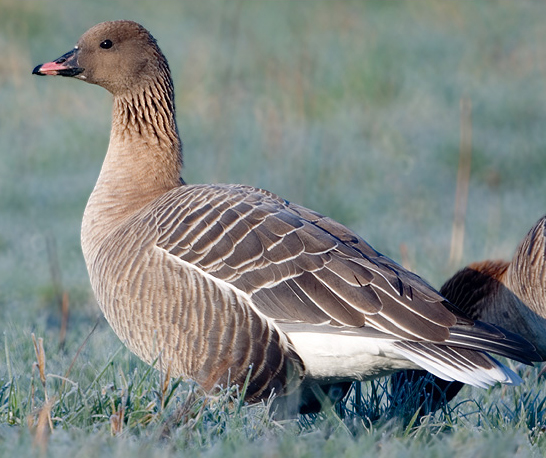The Bar-tailed Godwit is a fascinating species of bird with an incredibly unique lifestyle and behavior. It is known for its long beaks, exquisite plumage, and its incredible migratory feats. This article will take an in-depth look at the Bar-tailed Godwit, from its physical appearance and behavior to its diet, migration, breeding, and conservation.
The Bar-tailed Godwit, scientifically known as Limosa lapponica, is a large shorebird characterized by its long, curved bill. It has grey-brown upper parts and white underparts, with white stripes along its neck and back. The male typically has a reddish- brown head with a black crown. The female is similar in size and coloration to the male, but has a white head.
Bar-tailed Godwits can be found in coastal areas and wetlands from the high Arctic tundra to the lowland coasts of Europe, Asia, and North America. They breed in northern temperate and arctic regions and their non-breeding grounds extend to the western coasts of Africa, India, and Australia.
A Bar-tailed Godwit’s behavior is quite unique. They are quite social birds and prefer to live in large flocks of up to several thousand individuals. They often participate in large-scale aerial displays in which they all take off and then dive into the water as a group.
Bar-tailed Godwits are also known for their amazing migratory abilities. They migrate twice a year, once in the spring to their breeding grounds in the Arctic and again in the fall to their non-breeding grounds in the tropics. They fly non-stop for up to six days and nights, covering up to 12,000 miles.
The Bar-tailed Godwit’s diet consists mainly of insects, worms, and other invertebrates which they forage from the mudflats of their habitats. They also feed on small crustaceans and gastropods. Their diet varies seasonally and in different habitats, with diet changes in the winter months consisting of more plant matter.
In order to prepare for their long migratory flight, Bar-tailed Godwits must feed heavily and build up their fat reserves. They will feed for up to three weeks before departing for their migratory journey.
So the Bar-tailed Godwit is a fascinating species of bird with many unique features and behaviors that set it apart from other birds. In the following sections, we will take a closer look at its breeding, migration, and conservation.
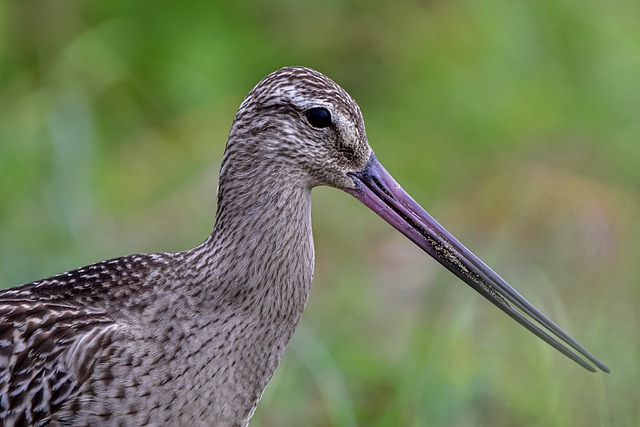
Behavior
The behavior of a Bar-tailed Godwit is unique and intriguing. This species is highly social and often forms small flocks of up to 10 individuals. They can be seen foraging together, preening, and displaying courtship behavior.
How do Bar-tailed Godwits behave? This species is primarily ground-dwelling, preferring to walk or run across the open grasslands and wetlands they inhabit, although they can take to the air if disturbed. They can be quite vocal, emitting a variety of calls to communicate their intentions and feelings.
What is the social life of a Bar-tailed Godwit? They are generally quite gregarious, often forming small flocks with other godwits and other species such as dunlin. During the breeding season, pairs become more territorial and can be seen engaging in courtship displays and vocalizations.
What are the unique behaviors of a Bar-tailed Godwit? When foraging, they have a characteristic bobbing of the head and tail, as well as an interesting habit of flipping over stones and vegetation to uncover aquatic invertebrates. They also have a peculiar way of perching on one foot while sleeping, with the other foot tucked up underneath their body for warmth.
In their breeding grounds, Bar-tailed Godwits have been known to use a wide variety of displays, including bowing, leaping, and aerial displays, to attract potential mates. As with all wading birds, they are highly territorial during the breeding season and will vigorously defend their nesting sites.
Bar-tailed Godwits are also known to be quite inquisitive. They often approach people and other animals in order to investigate, and can be seen bobbing their heads and making inquisitive noises.
In conclusion, the behavior of a Bar-tailed Godwit is quite fascinating, with its unique displays, vocalizations, and inquisitive nature. These traits make this species an interesting subject for observation.
Diet
Bar-tailed Godwits are omnivores, meaning they can eat both plant and animal matter. They feed mainly on invertebrates such as worms, snails, crustaceans, and spiders. They also eat small fish, molluscs, and aquatic plants. They hunt for their food by probing with their long beaks in the mud.
The diet of a Bar-tailed Godwit varies depending on the season and the habitat it is in. During the breeding season, they mainly feed on insects such as dragonflies, beetles, and midges. During the winter months, they will migrate and feed on mussels, crabs, and other marine invertebrates.
Bar-tailed Godwits are also opportunistic feeders. They will frequently follow ploughs and other agricultural equipment as they turn over the soil, looking for worms and other invertebrates to feed on. They will also feed on the edges of ditches, creeks, and lakes in search of aquatic invertebrates.
During the breeding season, Bar-tailed Godwits often feed in large flocks, often with other wading birds. This allows them to find more food as they can cover a larger area of land more quickly.
In some areas, Bar-tailed Godwits will also feed on crops such as wheat, barley, and oats. This can cause problems for farmers, who may have to take extra measures to protect their crops from the hungry birds.
Bar-tailed Godwits will also take advantage of human-supplied food sources, such as bird feeders. They are often seen in large numbers at bird feeders, particularly during the cold winter months. The provision of food by humans helps to supplement their natural diet and can help them survive during tough times.
Migration
The bar-tailed godwit is one of the most impressive long-distance migrants in the world. They undertake some of the longest and most impressive migratory journeys of any bird. Every year, they travel from their breeding grounds in Alaska, Siberia, and Northern Europe to their wintering grounds in New Zealand, Australia, and South East Asia.
Their migration of up to 11,000 kilometres is one of the longest non-stop migrations of any bird. To prepare for their long, arduous journey, they fatten up in their breeding grounds for weeks. This gives them enough energy and fat reserves to last for the duration of their migration.
They fly at an average speed of around 49 kilometres per hour and can cover up to 800 kilometres in a single day. During the journey, they take advantage of favourable winds and stop to rest and feed along the way. During their stopovers, they can double their body weight in fat before continuing their journey.
Bar-tailed godwits fly within flocks of their kind, always in search of a tailwind to save energy. They also fly at a lower altitude than most other bird species. This helps them to take advantage of thermals, which give them a boost of energy, while allowing them to stay close to the ground to look for food.
Bar-tailed godwits are able to cover such long distances with the help of an incredible navigational system. They use landmarks, such as mountain ranges, as well as the stars and the sun to guide them. Over the years, they have become very efficient at navigating and conserving their energy during their migrations.
To reach their wintering grounds in the southern hemisphere, bar-tailed godwits fly across the equator twice a year. This means that they have to adjust to the changing seasons and climatic conditions. They also have to face the challenge of adapting to the exact same environment on their return journey.
The sheer length of the bar-tailed godwit's migrations makes it one of the most fascinating creatures on the planet. It is an incredible feat to witness these birds endure such an extreme journey in search of food and better living conditions. No matter how far they have to go, bar-tailed godwits always find their way home.
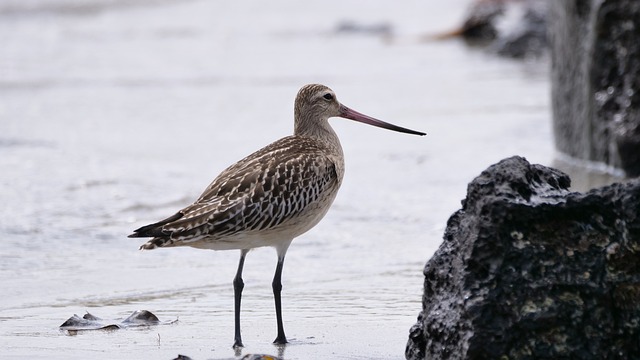
Breeding
Bar-tailed Godwits are long-distance migratory birds that breed in the Arctic tundra of Northern Europe, Asia, and North America. They have a unique nesting method that varies depending on the region they inhabit.
In Arctic Europe, Bar-tailed Godwits build nests in shallow depressions in the tundra, typically lined with moss, grass, and feathers. The female Bar-tailed Godwit will lay four or five eggs and both parents will take turns incubating them. The eggs are incubated for a period of three weeks and the chicks are then cared for by both parents until they are old enough to fly.
In Alaska, Bar-tailed Godwits will build their nests along mudflats in estuaries or on gravel ridges. They will also make use of mussel shells, seaweed, and driftwood to build their nests. In Asia, Bar-tailed Godwits will nest along the shorelines of the Yellow Sea and also use mussel shells, seaweed, and driftwood for nest construction.
In terms of mating behavior, Bar-tailed Godwits are monogamous and will typically form life-long pair bonds with their mate. During the breeding season, the male will perform a courtship ritual that involves a lot of aerial displays and fluttering of his wings. Once a pair is formed, the female will lay her eggs in the nest and the male bird will guard them until they hatch.
Once the chicks hatch, both parents will care for them, feeding them a diet of insects and other invertebrates. The chicks stay in the nest until they are about two weeks old and then fledge and learn to fly and forage for their own food.
Bar-tailed Godwits form a unique bond with their offspring and parents continue to care for them until they are fully grown. Studies have shown that the young birds form strong attachment bonds with their parents and will often return to nest near them in later years.
The breeding season of the Bar-tailed Godwit varies depending on the region, but generally occurs between early May and late June. The female will typically lay her eggs in late May and the chicks will fledge in late June or early July.
In conclusion, the Bar-tailed Godwit is a fascinating species that has an interesting breeding behaviour. They are monogamous birds that form strong attachments with their mates and their offspring and will travel long distances to return to their nesting sites each year. With careful conservation and protection, these amazing birds will continue to thrive.
Conservation
Bar-tailed Godwits are an important part of the ecosystem and are facing a range of threats to their survival. Conservationists are working hard to protect these birds and mitigate the effects of their habitat loss, climate change, and human intervention.
One of the major threats to Bar-tailed Godwits is the destruction of their habitats. Wetland areas are being drained and filled in for human development, and the birds are losing the places they breed and feed. This has led to a decline in the Bar-tailed Godwit population, as the birds are forced to find new places to live and breed.
Another major threat is climate change. The Bar-tailed Godwit faces a wide range of climate-related issues, from changing food sources to rising sea levels. Warmer, drier climates can cause the birds to struggle to find food, and rising sea levels can lead to the destruction of their habitats.
Human intervention is also a major threat to the Bar-tailed Godwits. Birds can be caught accidentally in fishing nets, and they can be disturbed or injured by human activities such as boats or cars. Conservationists are working hard to educate people on how to respect and protect these birds, and to limit the disturbance and destruction of their habitats.
To protect Bar-tailed Godwits, conservationists are working to restore and protect their habitats. Conservationists are also working to reintroduce Bar-tailed Godwits to areas where they have disappeared or been pushed out by humans.
For individuals concerned with the conservation of Bar-tailed Godwits, there are a number of ways to get involved. People can volunteer with conservation organizations, donate to conservation efforts, and spread the word about the importance of Bar-tailed Godwits and their habitats. Additionally, people can help protect these birds by reducing their impact on the environment and avoiding activities that would disturb or harm the birds.
By understanding the threats faced by Bar-tailed Godwits and taking action to protect them, we can ensure that these fascinating birds remain part of our ecosystems for years to come.
Summary
Bar-tailed godwits are a fascinating species of wading bird that are found in a variety of habitats around the world. These birds have a unique physical appearance that includes a mottled brown and grey plumage as well as a black tail with white tip. They are also known for their impressive migration patterns, which have been known to cover thousands of miles.
Bar-tailed godwits eat a wide variety of invertebrates, such as worms, snails, and insects. They can find food in many different habitats, and their diet varies seasonally. They have also developed an impressive ability to take advantage of different food sources, like mudflats or upland meadows.
During their migratory journey, bar-tailed godwits often travel thousands of miles, flying over the ocean. They prepare for these journeys by storing fat and building up strength for the long flights. The reasons why they migrate are varied, but often include changes in climate, food availability, and breeding opportunities.
When it comes to mating, bar-tailed godwits form monogamous pairs and usually breed in the same location each year. Both parents help in incubating eggs and caring for chicks. They also have a unique behavior of “splitting up” during the nesting period, with males and females each taking turns in caring for young.
Unfortunately, bar-tailed godwits face threats due to their limited habitats, as well as from predators, pollution, and climate change. Conservationists are taking steps to protect this species, such as creating protected areas, monitoring populations, and engaging with local communities. Individuals can also help out by becoming aware of the threats these birds face, and by supporting conservation efforts in any way possible.
In summary, bar-tailed godwits are an amazing species of bird. Not only do they have an impressive physical appearance, but they also undertake incredible migrations and have unique behaviors in their mating and parenting. Unfortunately, these birds are facing threats, but through conservation and public awareness, we can help ensure their future.
